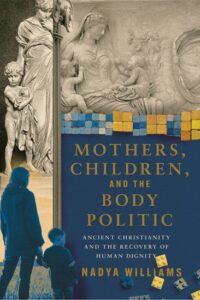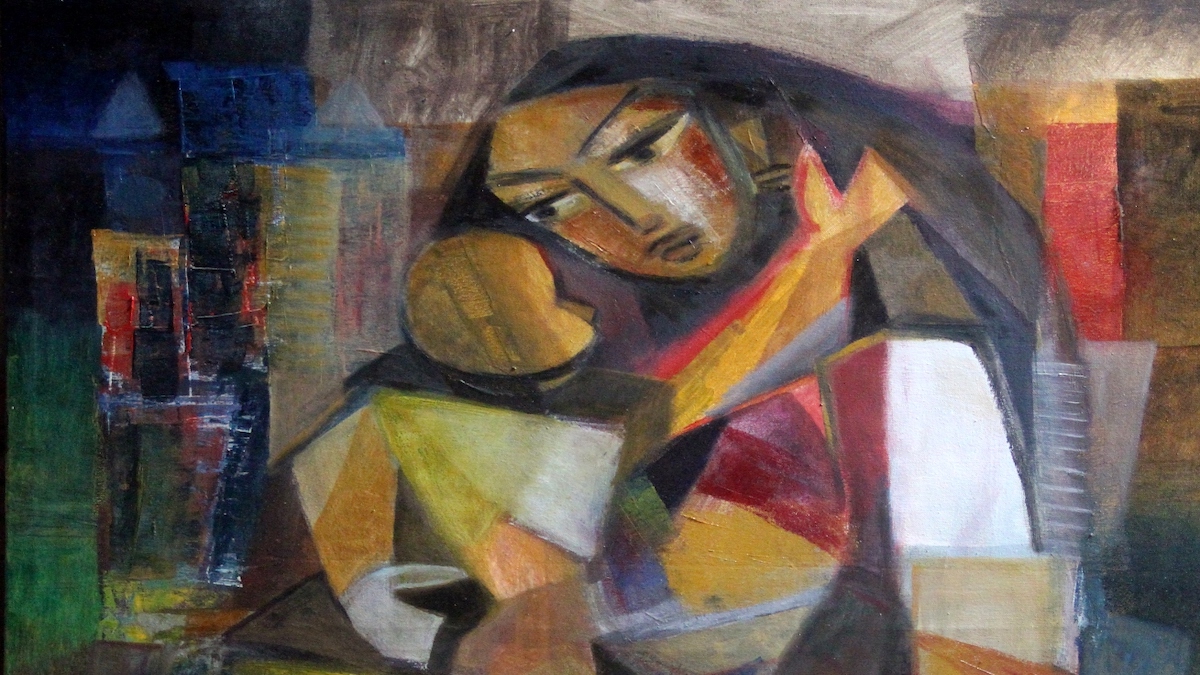We are accustomed to thinking of suffering as belonging to the event of death. But while an awareness of death has pervaded Western culture, the implications of suffering related to childbirth should be treated with equal interest.
In Natality: Toward a Philosophy of Birth, Jennifer Banks wants us to think of birth as an event that defines our lives as much as—if not even more than—death. As Banks rightly argues, natality is a remarkably underexplored subject. Still, Banks reminds us, there are thinkers for whom the idea of birth plays a pivotal role in how they conceive of and present the world to us. Throughout her brilliant book, Banks devotes one chapter to each of the following figures: Hannah Arendt, Friedrich Nietzsche, Mary Wollstonecraft, Mary Shelley, Sojourner Truth, Adrienne Rich, and Toni Morrison.
Following in their footsteps, Banks explores our negative assumptions about birth: that it is something passive, and therefore less valuable; that the mother’s body is a mere vessel, and therefore unimportant. Instead, Banks argues, birth “is an experience of neither mastery nor powerlessness; it confronts us with our embodied, earthly creativity, with what we can control and with what we simply cannot control.”
Banks is right to point out that birth is outside the binary of “mastery” and “powerlessness,” that it challenges our ambition for complete control of our reality, and that it reminds us of our embodiment. Yet the nod to “creativity” here doesn’t quite fit. Banks returns to this concept throughout the book, in an effort to reclaim birth as a positive, life-giving, admirable human experience. But if we root the experience of motherhood in a kind of creative act on her part, we risk conflating the mother (and father)’s roles in co-creation with God’s role as Creator. We also risk undervaluing pregnancy and childbirth as experiences of patience and sacrificial acceptance of suffering. Even for non-Christians, placing some distance between the idea of creativity and the experience of motherhood is important. Doing so can help us understand and value birth as an act of sacrifice for another, regardless of whether the mother experiences it as “creative” or empowering.
In short, a theology of birth—one based on Christ’s birth, life, and death on the cross—is just as essential as a philosophy of birth.
Julian of Norwich
In her descriptions of Christ’s passion, medieval English mystic Julian of Norwich points to the physical suffering of childbirth as the model for one’s death of the self, and one’s consequent spiritual rebirth. Although Banks does not devote a chapter in her new book to Julian’s work, Banks has clearly been deeply affected by Julian’s Revelations of Divine Love, which she discusses in a brilliant Comment article from 2021 (“Mortality and Natality in the Pandemic”).
Banks is struck by Julian’s experience of debilitating physical illness at the age of thirty, but even more so by the “indestructible joyousness” Julian felt while in pain. Julian sees meaning in her suffering; she compares Christ’s crucifixion to the experience of labor in that they are both at once painful and redemptive. Julian’s state of wellbeing while in pain, Banks observes, “was based on the fundamental union between self and God, Jesus and Mary, humankind and an earthly, embodied natural world.” Julian’s theological vision, Banks further argues, is one that recognises
The profound vulnerability of human life, our fallenness, our relational dependence, the needs and demands of sustenance, and the pain of death and disease, but it also depicts the blissfulness of our eternal gestating. Jesus dies on the cross, but he also gives birth to us there.
I can’t help but wish that Julian had been discussed in Natality too. This article is therefore my attempt to contribute to the discussion of natality started by Banks, by reflecting on how we can look to the Revelations of Divine Love to develop a theology of birth.
Julian uses maternal imagery when referring to Christ throughout the Revelations. By portraying Christ’s suffering as closely aligned to the suffering of labour pains, Julian offers a theology of birth and motherhood as grounded in the acceptance of suffering for the sake of the creation of life. To be sure, in the Christian worldview, men, too, are called to suffer—laying down their lives for their wives in imitation of what Christ did for the Church—but this is a different form of suffering, one that embodies a different aspect of Christ’s death on the cross. A father is called to protect his child’s life, but his body is not designed to grow and nurture that life. A man may imitate Christ’s passion by his willingness to risk his life to preserve that of his child. A mother’s imitation of the passion takes the form of risking her own life to allow her child, created by God, to grow and be born into the world.
Let me be clear: we should not weaponize the concept of self-sacrificial suffering to argue against alleviating the pain of childbirth through modern medicine. I received an epidural during the birth of my son, and I can assure you that it was still an incredibly painful experience. Likewise, we should increase efforts to reduce rates of maternal mortality. Nonetheless, some level of physical discomfort and risk is likely to remain a part of pregnancy and birth. Although that burden should not be overly glorified, it should be valued, and mothers should be admired for undergoing it. Understanding the connection between labor pain and Christ’s passion can help us understand why.
A Maternal Christology
As medieval historian Caroline Bynum notes in her book Jesus as Mother, in earlier Cistercian and patristic writing, Jesus’s motherhood is described in relatively abstract terms. When Bernard of Clairvaux uses maternal imagery, for example, this is “almost without exception elaborated not as giving birth or even as conceiving or sheltering in a womb but as nurturing, particularly suckling.” By contrast, Julian extensively elaborates on a model of motherhood based on physical suffering for the sake of new life.
From the beginning of the Revelations, Julian depicts Christ’s suffering in the most vivid terms. She recounts seeing Christ’s “body plenteously bleeding”; his “fair skin had been broken full deep into the tender flesh by sharp blows,” and the “hot blood ran out so plenteously that one could see neither skin nor wound, but it looked as though it was all blood.” The examples build up until chapter sixty, where Jesus’ suffering is directly and unmistakably described as labour pain. “Thus he sustains us within him in love, and laboured into the full time until he suffered the sharpest throes and the most grievous pains that ever were or ever shall be, and died at the last.”
Christ, Julian argues, suffered the greatest physical pain that can ever be experienced in childbirth, and through the gift of his unconditional love and his acceptance of suffering, he has given us a new kind of spiritual birth. He does not simply act as a spiritual mother in the sense of feeding us with His wisdom and love; rather, he takes on the actual, literal, physical suffering of mothers so that a new kind of humanity can be born. Christ’s pain leads us “endless living,” to eternal life.
Neither Passive nor Active
As medieval scholar Barbara Newman argues in her recent book The Permeable Self, it is difficult to detangle the experience of motherhood from negative connotations about the “passivity” involved in childbearing. It is very easy to try and salvage the experience of birth by merely reversing it to an “active” role. In her discussion of Julian’s maternal imagery, Liz Herbert McAvoy, who otherwise has many helpful insights on the Revelations, falls into this trap, arguing that “Julian also appears to be actively transforming an apparently internalised sense of female inadequacy from a passive concept into an active and authoritative agent of redemption.” Likewise, as I mentioned, in Banks’ Natality the idea of creativity plays a significant role in framing the experience of motherhood. But this comes with its own risks.
To reframe the experience of birth as “active” and “creative” does not necessarily help us understand motherhood better than thinking of childbearing women as passive instruments of creation. After all, there is so much about the process of labour and childbirth, like childrearing, that is in fact very much out of our control, as Banks herself points out.
I am here reminded of a book by late British pediatrician and child psychologist D. W. Winnicott called The Child, the Family, and the Outside World (1964), in which Winnicott, addressing mothers directly, attempts to placate their fears that the child’s development is entirely dependent on them, by reminding them that so much of the process of creation and growth only needs to be aided by their motherly love:
Some of you have created works of art. You have done drawings and paintings, or you have moulded out of clay, or you have knitted jumpers or made dresses. When you did these things, what turned up was made by you. Babies are different. The baby grows, and you are the mother providing a suitable environment.
The mother, for Winnicott, is no creator, but she is no passive vessel either. She is more like a kindly host, caring for a rather vulnerable and dependent “lodger.”
Here, the parallel between a mother’s milk and Christ’s blood are particularly helpful. Christ sets the example by feeding us “full tenderly with the blessed sacrament.” Just so, mothers continue to care for their children after their birth by nursing them. Even when they are grown, her “working” to protect her child is never done. Indeed, the willingness to sacrifice some personal autonomy to prioritize care and nurture of one’s children is thus a fundamental characteristic of Christ-like motherhood for Julian.
Birth and Death, Beauty and Pain
In our contemporary society, which values bodily autonomy over sacrifice, and thus undervalues the astonishing things a woman’s body can do, Julian’s perspective can feel revolutionary.
We are accustomed to thinking of birth and death as separate events, but for Julian, Christ’s Passion connects them by reminding us that we must die to ourselves in order to be spiritually reborn. Although maternal mortality rates are much lower now than in the past—and should be far lower still—women still risk their lives and their health for the good of children being born. They endure protracted, lingering pain over which they have little control. If they choose to nurse their children, they freely surrender their bodily autonomy for the benefit and nourishment of their newborns, knowing that their bodies will be depleted, and that, for the first few months of their infants’ lives, they will have little sleep and little strength.
And yet, we rightly speak of birth and motherhood as “beautiful.” Just so, Julian describes Christ’s body at the crucifixion as both a horrible sight in His suffering, and yet a beautiful sight, also. His body is not only “hideous and dreadful” but also “sweet and lovely.” Julian finds beauty in suffering for the sake of another, because she believes that through death Christ reveals our salvation. In a parallel way, motherhood requires the pain of childbearing to reveal new life.



